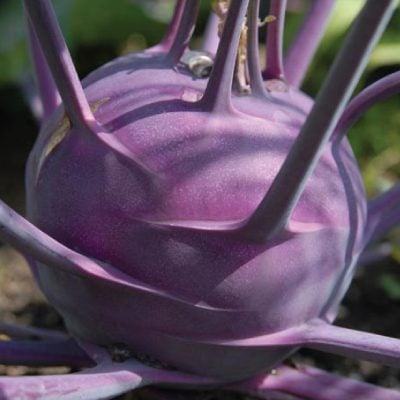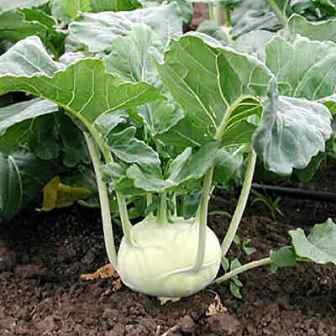
Learning Download: How to Grow Kohlrabi
From Seed to Harvest: A guide to growing kohlrabi.
Also known as German turnip, kohlrabi has a texture and taste similar to broccoli stems and can be eaten raw or cooked. It is a member of the cabbage family and is one of the hardiest vegetables as it tolerates colder weather better than other garden crops. This crop provides nutrients like Vitamin C and fiber when eaten.
To plant:
Kohlrabi can be sown outdoors as soon as soil can be worked. Sow seeds 1/4 inch deep in double rows set 1.5 feet apart. For a fall crop, plan your harvest for a week or two after the first fall frost. Kohlrabi takes 55 days to mature. Seeds also can be started indoors four to six weeks prior to moving the plant outside.
To grow:
Once seedlings appear, thin them to 6 inches apart. Kohlrabi does best in full sun in soil with a pH of 6.0 to 6.8. For best growth, water 1 inch per week and keep the area weeded. The bulb, which is the stem, should sit just above the soil as it grows. As it is a member of the cabbage family, kohlrabi can be a victim to cabbage moths and other pests. Protect the plants with floating row covers and prevent disease by using a four-year crop rotation.
To harvest:
Kohlrabi is ready to harvest when its bulb is 1 to 3 inches in diameter, or about the size of a tennis ball. Do not pick the vegetable in warm weather, as the root becomes woody. Kohlrabi leaves are also edible. Boil them or use them in salads.
What kohlrabi craves:
Upon planting, work in a general-purpose fertilizer to quicken growth. You also can amend the soil with composted manure upon planting. Once the plant is established, fertilize every three to four weeks with a general-purpose fertilizer.
Where to buy kohlrabi seeds:
You can find both purple and white kohlrabi seeds at Urban Farmer.
Learning Download: Common pests and diseases: Kohlrabi
Common pests and diseases: Kohlrabi
When growing vegetables, it is always exciting to care for the plant throughout its growing phase and then harvest it for delicious recipes later on, but one thing to watch out for is pests and diseases. Different plants are susceptible to different types of pests and diseases, and it is important to make yourself aware so you can keep a watchful eye and also take any preventative methods to keep your plants safe throughout their lifespan.
Kohlrabi can fall victim to several different pests and diseases, many of which are similar to the problems affecting greens.
Pests:
A few of the common pests affecting kohlrabi include the beet armyworm, the cabbage aphid, the cabbage looper and more.
THe beet armyworm will cause leaves to appear skeletonized due to heavy feeding. Use organic methods to control this insect such as Bacillus thuringiensis.
Cabbage aphids can stunt plant growth and even cause death. THe insects are gray-green and will be visible on the leaves. These aphids only feed on cruciferous plants but can survive on related weeds. If the infestation isn’t bad, prune out the affected leaves. However, if the infestation is heavy, spray the sturdier plants with a strong jet of water to knock the aphids off the leaves.
Cabbage loopers will cause extensive damage in the leaves. The caterpillars are green and have white lines on each side of their body. They will overwinter in crop debris. Handpick the larvae off the plants or apply Bacillus thuringiensis to kill the younger larvae.
Diseases:
Some of the common diseases affecting kohlrabi include Alternaria leaf spot, black rot, damping-off, clubroot, downy mildew and more.
Alternaria leaf spot will cause small spots on the leaves that are darker and will later turn brown or gray. Lesions may appear round or angular. The lesions may then form rings and become brittle and crack. This disease is most likely to become a problem during cool, wet periods. The best ways to prevent this from happening is by planting pathogen-free seeds, practice crop rotation and apply the correct fungicides to control the Alternaria leaf spot when it occurs.
Black rot will cause seedlings to develop yellow or brown leaves that wilt and collapse. It is most prevalent in warm, wet conditions. To control this disease, practice good sanitation, plant disease-free seed and rotate crops.
Damping-off will kill seedlings after they germinate. Symptoms include black rot girdling on the stem, and the seedlings may remain upright but the stem will appear constricted or twisted, which is why damping-off also is known as wirestem. It favors cool temperatures. To prevent this, plant pathogen-free seeds and apply fungicides when necessary.
Clubroot will cause plants to be slow growing or stunted, and the leaves will turn yellow and wilt during the day. To avoid this disease from occurring, plant certified seeds and apply lime to the soil.
Downy mildew will cause irregular yellow patches which turn brown. These patches are located on the leaves. A gray growth will appear on the bottom of the leaves. The disease is more likely to occur when the environment is cool and wet. To prevent this, remove crop debris and practice good crop rotation.


